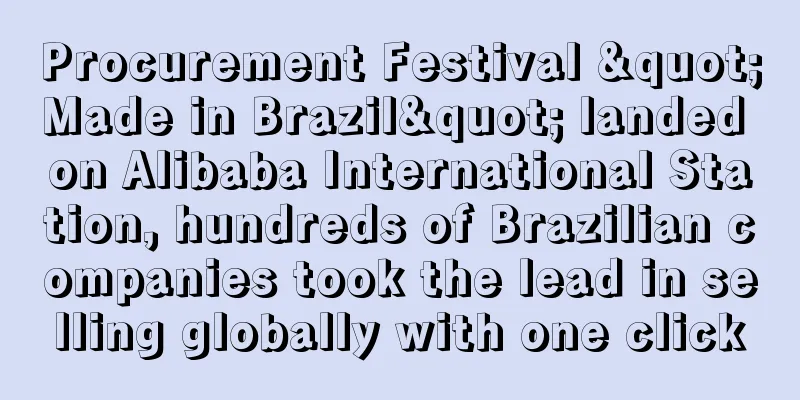Increased revenue by nearly 70 million in one year! E-commerce companies easily unlocked the second growth curve

|
Statistics show that in the past five years, the scale of China's cross-border e-commerce has grown nearly 10 times, with an annual growth rate of more than 30%, accounting for nearly 40% of international trade. Against this background, the tide of going overseas has become increasingly turbulent. However, as more and more people enter the track, the competition faced by pan-e-commerce companies (broader than the concept of e-commerce, referring to all transactions and business models covering physical objects, services, and virtual goods) has increased. How to stand out from the crowd of competitors has become an urgent problem they need to solve.
Traffic costs have increased by 30% in the past two years, and the profits of pan-e-commerce companies have been eroded
Under the influence of the COVID-19 pandemic, cross-border e-commerce, which was already running forward , seemed to have been accelerated. Data shows that global online sales grew by 27% from 2019 to 2020, exceeding the average annual growth rate of 22% from 2016 to 2019. The proportion of online sales in total retail sales increased from 14% in 2019 to 19% in 2021.
Riding on the rapid development of the industry, a number of cross-border e-commerce companies have achieved outstanding results, such as Anker Innovations, which has been successfully listed on the A-share market, and SHEIN, which is valued at US$100 billion and has already exceeded 10 billion in annual revenue. In particular, SHEIN is expected to achieve revenue of US$24 billion this year, and GMV will increase by 50% to US$30 billion, according to a report by the Wall Street Journal in October.
However, while the rapid market development has brought unprecedented development opportunities to cross-border e-commerce companies, the challenges are also increasing.
As more and more companies set sail for overseas markets, competition in the market is becoming increasingly fierce. Companies have clearly felt the rapid increase in various costs, among which the increase in traffic costs, which is an important part of sales costs, is particularly obvious. According to Revealbot data, the CPC (a type of pay-per-click advertising) of some platforms has even increased by more than 30% since the beginning of 2020.
The same is true from the perspective of enterprises. For example, the financial report shows that the advertising expenses of Lechuang, a big seller on independent websites, were 61.93 million yuan in 2019, and have risen to 144 million yuan in 2021, an increase of more than 50% in two years. For cross-border e-commerce companies, advertising fees are one of the three major sales costs in addition to platform service fees and logistics fees. A sharp increase in advertising fees means that profits are greatly reduced.
However, even though companies continue to increase advertising investment, it has not significantly boosted conversion rates. In the past two years, the conversion rate of the pan-e-commerce industry has been between 2% and 3%. This means that out of 100 consumers attracted by advertising , 97 left without completing the purchase and without creating any value.
Under such circumstances, it is urgent for pan-e-commerce enterprises to find a way out. At present, most enterprises mainly adopt two methods: first, strengthen core business, such as opening up new markets, etc.; second, explore external opportunities, such as changing business models or entering new business areas .
However, these two methods are extremely uncertain and take a long time to implement . At this time, a method of generating revenue by using online content and traffic has gained attention, namely advertising monetization. Pan-e-commerce companies can sell advertising space to advertisers to obtain advertising revenue.
Advertisements of pan-e-commerce enterprises can also be monetized. Seize this overlooked opportunity
I believe that many pan-e-commerce companies are still relatively unfamiliar with advertising monetization, especially e-commerce companies that mainly sell goods online. In fact, games, mobile applications, news media, etc. have already integrated advertising monetization into their business models and obtained continuous income from it.
Data shows that as of the fourth quarter of 2021, the average transaction conversion rate of global online sales was only 2.5%. This means that the traffic purchased by companies at a high price was wasted in the end. Based on this, advertising monetization has a lot of achievable foundations in pan-e-commerce companies.
Although the data has pointed out the direction, e-commerce companies are still concerned about this unfamiliar method of advertising monetization.
First of all, what worries them most is "stealing a chicken but losing the rice", that is, damaging the brand image and affecting the platform conversion. After all, for them, user experience is always the primary consideration, and they don't want to see users being attracted to the advertiser's website but not making any purchases on the platform.
Second, they believe that only traffic giants can earn substantial profits through advertising, and their own traffic is limited, so the advertising revenue they can bring is limited. Among the 14 pan-e-commerce companies in the Asia-Pacific region surveyed by Google, some of the interviewed companies are worried that the advertising business cannot generate enough revenue and is therefore not worth investing in.
Third, excessive initial investment and uncontrollable advertising content. Although some decision makers have realized that advertising is an effective way to monetize, they also believe that advertising monetization is a heavy and complicated project, and they are not clear about what skills and types of employees are needed. Does it require millions of dollars of investment in the early stages? Will it distract the energy and resources of the core business?
However, Kantar and Google's research shows that third-party advertising does not erode conversion rates or affect shopping experience. Instead, consumers welcome ads that provide useful, relevant and interesting information. Deloitte's interviews, research and analysis show that third-party advertising helps pan-e-commerce companies realize multiple values, including creating incremental revenue, reaching multiple advertisements, and enriching the platform.
A discount website based in Asia Pacific is one of the pan-e-commerce companies that has benefited from advertising monetization. As the cost of traffic acquisition in the industry continues to rise, the website spends a considerable portion of its marketing budget every year to acquire new users and drive traffic from social media and other advertising platforms.
Under such circumstances, the website began to look for other sources of income in order to obtain income other than commissions to subsidize marketing expenses. Advertising monetization became the main solution to the problem.
Currently, the website's annual advertising revenue exceeds 10 million US dollars (approximately 69.75 million yuan based on the exchange rate on December 12), accounting for about 40% of the total revenue. Advertising revenue is basically the same as its original commission business revenue.
In an urgent effort to seize the second growth curve, how can the advertising monetization business be implemented?
Seeing the above data and cases, I believe that many e-commerce companies that are deeply troubled by traffic costs have begun to understand advertising monetization and its implementation methods.
It is understood that pan-e-commerce enterprises can carry out advertising monetization business through the "PRO Three-Step Plan".
"P" stands for Positioning , which clearly defines the positioning of advertising monetization, ensures consistency with corporate strategy, and determines business evaluation indicators.
Before launching advertising monetization business, decision makers must first clarify the role of advertising monetization in the overall strategy based on the nature of the business and original parameters. Advertising monetization can significantly increase total revenue "increase income" or "transfuse blood" for investment in other businesses. Different departments within the company must reach a consensus on the goals of launching advertising business.
Decision makers can determine the evaluation indicators of advertising business based on the positioning of advertising monetization to guide business planning and execution.
" R" stands for Resources (allocation of resources) , confirm internal capabilities and resources, select appropriate tools, and form a corresponding team.
After clarifying the positioning and assessment indicators, the company must confirm the internal capability readiness and resource allocation. Currently, companies mainly use two methods to carry out advertising monetization business: building their own advertising direct sales team and system or deploying third-party advertising monetization solutions.
The first one has the advantage that companies can choose advertisers and advertising content on their own. The second one is simpler to implement, requires less investment, and has a lower entry threshold.
"O" stands for Optimization . Choose the appropriate ad position and ad format, test first and then promote, and continuously optimize.
After confirming internal resources and selecting appropriate tools, companies need to carefully consider where to place ads and what kind of ads to place. Analysis of the advertising monetization revenue structure shows that ad location and ad format are two key factors that determine advertising revenue.
For example, the above-mentioned discount website mainly used banner ads in the early stage of advertising business monetization, but later found that banner ads alone could not fully tap the advertising value of the platform. Subsequently, it cooperated with Google and adopted a new advertising form: search ads, which achieved unexpected results.
Within one year of the website's collaboration with Google to run search ads, advertising revenue increased by 610% year-on-year and click-through rate increased by 274% year-on-year.
If you want to learn more about Google's third-party advertising monetization solution, please click http://services.google.cn/fb/forms/commerce2022/ to download the full report. Pan-e-commerce enterprises Traffic Monetization |
<<: Is the US online shopping boom over? Walmart's online traffic fell 8%
Recommend
What is HyperPay? HyperPay Review, Features
HyperPay is a leading payment gateway in the Midd...
Easter spending in the U.S. to reach $20.8 billion, with low-priced goods popular
According to data from NRF and Prosper Insights &...
A must-read for cross-border merchants! Tmall Global’s deposit is “unsealed” for the first time
On July 29, Tmall Global released three new merch...
What is Boshen Intellectual Property? Boshen Intellectual Property Review, Features
Boshen Intellectual Property is a professional int...
United Nations Small and Medium Enterprises Day: Alibaba International Station shares "Chinese experience", AI becomes the key word
June 27th is the "Micro, Small and Medium En...
What is Shenmahui Intellectual Property? Shenmahui Intellectual Property Review, Features
Shenmahui Intellectual Property is committed to p...
Amazon has helped 2.5 million small and medium enterprises in India to digitize
Amazon India said on Thursday that it has digitiz...
The United States and some other countries want to release 60 million barrels of oil to cope with the surge in oil prices
According to foreign media reports, the United St...
Amazon may need three years to recover from warehouse overexpansion
According to consulting firm MWPVL International,...
What is Sumpay? Sumpay Review, Features
Sumpay Internet payment, tailor-made payment solu...
Quick Look! The Latest Trends in the US Market
According to the U.S. Census Bureau , spending in...
What is Zhejiang Tuao Operation? Zhejiang Tuao Operation Review, Features
Zhejiang Tuao Network Technology Co., Ltd. is a pr...
Attention! Some sellers’ custom URLs are no longer available
Recently, Amazon announced that on December 31, 2...
Retailers are increasing their investment in online platforms, and competition in the e-commerce sector will become more intense in 2022
Linnworks has released new findings from an inter...
TikTok playback volume reaches 700 million, and the internet celebrity dishcloth becomes popular!
Household cleaning tools are commonly used items ...









